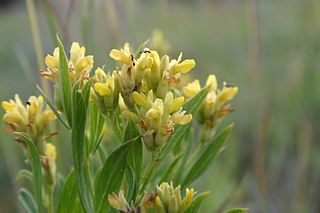
Pterocarpus is a pantropical tree genus in the Fabaceae family. It belongs to the subfamily Faboideae, and was recently assigned to the informal monophyletic Pterocarpus clade within the Dalbergieae. Most species of Pterocarpus yield valuable timber traded as padauk, usually pronounced or ; other common names are mukwa or narra.

Cyamopsis is a genus of the family Fabaceae. Its species are distributed across sub-Saharan Africa, Saudi Arabia, Pakistan, and India. Typical habitats include tropical seasonally-dry thorn scrub and grassland, often in floodplains, stream beds, and pans, and in open sandy or rocky areas.

Xanthocercis is a tree genus in the family Fabaceae. It includes three species native to sub-Saharan Africa.

Dipteryx is a genus containing a number of species of large trees and possibly shrubs. It belongs to the "papilionoid" subfamily – Faboideae – of the family Fabaceae. This genus is native to South and Central America and the Caribbean. Formerly, the related genus Taralea was included in Dipteryx.
Alexa is a genus of flowering plants. It includes ten species which are native to Venezuela, Guyana, Suriname, French Guiana, and northern Brazil in northern South America. Members of this genus accumulate iminosugars in their leaves.

Baphia is a small genus of legumes that bear simple leaves. Baphia is from the Greek word βάπτω, referring to a red dye that is extracted from the heartwood of tropical species. The genus is restricted to the African tropics. Baphia was traditionally assigned to the tribe Sophoreae; however, recent molecular phylogenetic analyses reassigned Baphia to the tribe Baphieae.

Kotschya is a genus of legumes in the family Fabaceae. It includes 30 species native to sub-Saharan Africa. The genus was recently assigned to the informal monophyletic Dalbergia clade of the Dalbergieae. It contains the following species:

Myrocarpus is a genus of flowering plants in the family Fabaceae. It includes five species of trees native to tropical South America, ranging from Venezuela to northern Argentina. Typical habitats include wet to seasonally-dry tropical lowland forest and woodland.
Ormocarpum is a genus of flowering plants in the legume family, Fabaceae. It includes 17 species native to tropical and southern Africa and parts of India, Indochina, Malesia, Papuasia, and the South Pacific. The genus was recently assigned to the informal monophyletic Dalbergia clade of the Dalbergieae.

Pericopsis is a genus of flowering plants in the legume family, Fabaceae. It includes four species of trees and shrubs, three native to sub-Saharan Africa and one to Sri Lanka, Malesia, New Guinea, and the Caroline Islands. Typical habitats include tropical lowland forest and seasonally-dry woodland and wooded grassland.

Aeschynomene is a genus of flowering plants in the family Fabaceae, and was recently assigned to the informal monophyletic Dalbergia clade of the Dalbergieae. They are known commonly as jointvetches. They range across tropical and subtropical regions of the Americas, sub-Saharan Africa, south, southeast, and east Asia, and Australia. These legumes are most common in warm regions and many species are aquatic.

Pearsonia is a genus of 12 species of plants belonging to the family Fabaceae and occurring in Africa south of the equator with 1 species found on Madagascar. The species are usually herbs or shrublets with woody rootstocks. Leaves are usually sessile and 3-foliolate. The inflorescence is a congested or lax terminal raceme. The name of this genus commemorates the South African botanist Henry Harold Welch Pearson.

Adenolobus is a genus of African flowering plants in the legume family, Fabaceae. It belongs to the subfamily Cercidoideae.

Griffonia is a genus of central African flowering plants in the legume family, Fabaceae. It belongs to the subfamily Cercidoideae. Griffonia is known to have a high concentration of 5-HTP in its seeds.
Candolleodendron brachystachyum is a species of flowering plant in the legume family, Fabaceae. It belongs to the subfamily Faboideae. It is the only member of the genus Candolleodendron. It is a tree native to the Amazon rain forest of northern Brazil (Pará), Suriname, and French Guiana.

Humularia is a genus of flowering plants in the legume family, Fabaceae. It includes 34 species native to sub-Saharan Africa, ranging from South Sudan to Cameroon, Angola, Malawi, and Tanzania. Species include herbs with woody bases and occasionally small shrubs. Typical habitats include seasonally-dry tropical woodland, wooded grassland, scrub, and grassland, often along stream banks, swamp margins, floodplains, and sandy areas, and sometimes in montane areas. The genus belongs to the subfamily Faboideae, and was recently assigned to the informal monophyletic Dalbergia clade of the Dalbergieae.
Monopteryx is a genus of flowering plants in the family Fabaceae. It includes three species of trees native to the Amazon rainforest of northern South America, ranging through parts of Colombia, Venezuela, northern Brazil, and French Guiana. They grow in non-inundated lowland tropical rain forest on sandy soil. The genus belongs to subfamily Faboideae. Members of this genus produce hydroxypipecolic acids in their leaves.
Petaladenium urceoliferum is a species of flowering plant in the family Fabaceae. It is a tree native to northern Brazil. It grows in tropical lowland Amazon rainforest in the basin of the Rio Negro, a northern tributary of the Amazon. It is the only member of the genus Petaladenium. The genus belongs to tribe Amburaneae in subfamily Faboideae.

Salweenia is a genus of flowering plants in the family Fabaceae. It includes two species of evergreen shrubs native to Tibet and Sichuan. It belongs to the subfamily Faboideae. They grow in dry continental temperate montane habitats, typically thickets on dry stony slopes, on gravel terraces, and in sandy stream beds.
Microcharis is a genus of flowering plants. It includes 36 species of herbs and shrublets native to Africa and the Arabian Peninsula. The genus is in tribe Indigofereae of family Fabaceae. Typical habitats include seasonally-dry tropical forest margins, woodland, thicket, wooded grassland, and grassland, often in damp, swampy, or riverine areas, or in shallow soil over rocks.













